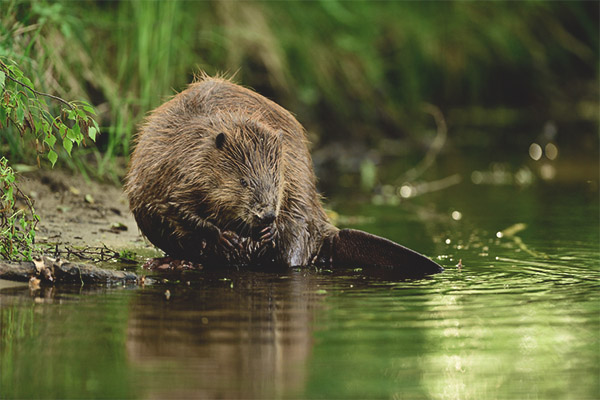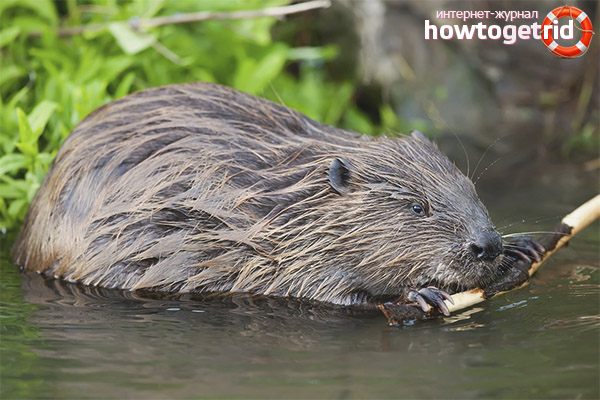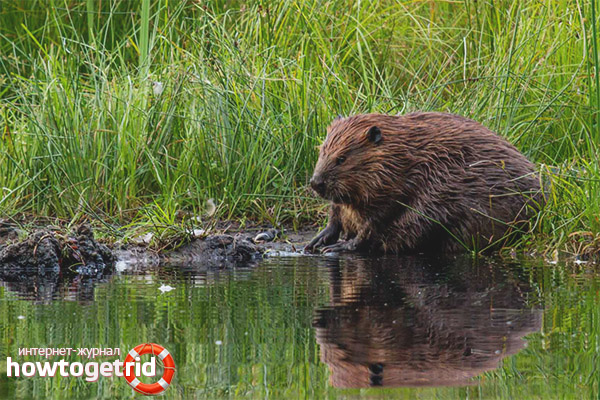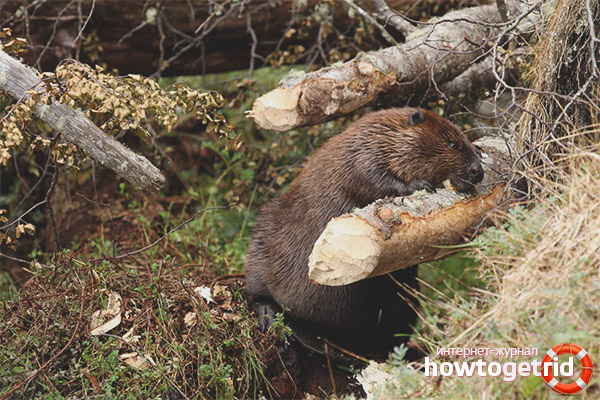The content of the article
By ordinary beaver is meant a semi-aquatic animal, which belongs to the order of rodents. Otherwise, this representative of the family is called river in view of the fact that the rodent prefers to dwell in the corresponding water sources. The animal is able to hit even the most experienced person who deals with such animals. He perfectly builds housing, cares for the offspring and produces food. By its dimensional features, this rodent is the second of the largest. In today's material we will consider everything connected with it.
Description
- The largest animal among rodents is considered a capybara, the beaver with honor occupies the second place. Mammal is famous for its dimensional features, which gives it an awesome look. Such animals prefer to lead a half-water mode of existence.
- If we consider their dimensions, then adult animals can grow in size up to 1.3 m. You will agree that it is impressive. In this case, the shoulders grow to 35 cm, and body weight varies in the range of 30 kg. Gender differences between these individuals are expressed poorly. We can only say that the females are slightly larger than the males.
- The body format is squat, the limbs are short, with five fingers. The most developed are the hind limbs, they account for emphasis. Due to the fact that animals prefer to live to a greater extent in the water, their gaps between the fingers are equipped with membranes. The claws are strong and strong, causing lacerations in the process of collisions.
- The tail is given special attention. There is no coat on it. The format of the tail looks like an oval, elongated and very flat. In length it grows up to 30 cm. The width is about 13 cm. In some individuals hairs can be observed in the main part. The tail itself seems to be covered with keratinized scales-scales. Between them there is a very short and hard pile. The upper part is characterized by the presence of the keel.
- Despite the fact that these individuals are considered to be large, their eyes are small.The ears are also not famous for their majesty, they hide under the hair and practically do not stand out against the background of the head. When an animal sinks into the water, its nostrils close, as do the holes in the ears. On the eyes descend the membrane, which are called blinking.
- Root dentition is characteristic of the rootless type. However, a separate root system may be present in adults due to age characteristics. The incisors are located at the back of the mouth. They are growths that are isolated from the mouth. It is this trait that allows beasts to gnaw whatever they want in the aquatic environment.
- The animal fur is pigmented with black, dark brown, brownish, chestnut shades. He is famous for having a dense cushion with oily impregnation. The guard hair itself is hard and long. The paws are colored black, as well as the tail, although the latter may have a dark gray pigment. Shedding is carried out once a year. It begins in late spring, ends with the beginning of winter or the end of autumn.
- The anal zone is equipped with paired glands, as well as a beaver jet, the main purpose of which is to give a signal about gender and other characteristics of a particular individual. Their jet exudes a secret with enhanced odor.This fragrance allows other individuals to navigate among the entire beaver settlement and select a particular member of the pack.
Lifestyle
- The discussed members of the family prefer to live near slow-flowing water sources, be it rivers or storages. They also like fully standing sources, such as ponds or lakes. Beavers occupy the shoreline and are scattered in this area. They do not mind settling in careers or old women. Fully suspended from water sources with a rapid flow, as well as those places that freeze through almost to the bottom during the winter season.
- These individuals require vegetation growing in the coastal part. They prefer shrubs and wood, like larch. Also like herbs that form the basis of the diet.
- Animals are at the same time excellent divers and swimmers. Their lungs are huge, as well as the liver. All this allows you to gain enough air to swim the required distance and be in the water space up to 15 minutes. When a mammal goes to the shore, it feels not safe, it looks awkward.
- When danger is brewing, the rodents, with all their strength, begin to spank with their tail shovels on the water surface, then also quickly hide in the aquatic environment. They are thus alarming for all other family members so that they disappear in time.
- Accommodation is carried out individually or in small groups. A family may consist of 7 individuals, which are represented by a couple and their offspring. If a family occupies a certain territory, then it is listed as a family for several more years and even more.
- If the water space is relatively small, it can take a bachelor or a small family. But larger areas are assigned to groups. Beavers try not to depart from water bodies beyond 150 m. Because this increases the risk to life.
- These individuals bypass their possessions, after which they mark the borders with a secret, which urges not to leave their homeland. With regard to the period of activity, these mammals prefer to stay awake at dusk or at night.
- With the onset of the autumn or spring season, adult members of the family leave the home in the evening, after which they work throughout the night.When it is cold or cold, these individuals very rarely crawl to the surface.
Lifespan
- Considering the period of existence in the natural environment, we can say that in such conditions they are up to 15 years. If you keep mammals in captivity, they will live for about 20-25 years. Life is shortened due to the presence of enemies in nature and some diseases characteristic of these rodents.
- Even if we take into account that animals are famous for their excellent immune system, they can still get sick. Among the most common ailments emit infection, including tularemia. Because of her, animals simply die.
- Also, the population is affected by special weather conditions, including winter floods. For example, they can take the life of more than half of the beaver population. And spring floods lead to the death of young, which is not adapted to such situations.
Population
- Discussed individuals that rank in the ordinary or Eurasian segment have long been inhabited by the countries of Europe and Asia, respectively. But at some point a ruthless hunt was started on the beavers, which led to a significant reduction in the population. Today the population is very small, it is practically on the verge of extinction.
- At the beginning of the 19th century, practically in all the territories of the above-mentioned countries, these rodents did not remain at all. In the 20th century, the population numbered about 1,300 individuals. Created groups that monitored the population and punished violators. Therefore, the number of beavers has increased in Europe, while in Asia it is recovering, but slowly.
Value
- On the presented mammals they began to hunt in view of the fact that their fur is very much appreciated. Rodents were also caught for the beaver stream, which is often used in the production of perfumery, pharmacology and medicine.
- The meat of this animal is considered a delicacy. Catholics altogether equate it with lean varieties. However, today it is known that the beaver can tolerate salmonellosis, partly because of this, its meat is no longer consumed in such quantities.
Characteristics
- It is worth noting that the individuals represented live in burrows. Such dwellings are sometimes called huts. An interesting fact is that the entrance to their house is always located under water. Most often, rodents begin to dig a hole on a steep steep bank.Such a dwelling is presented in the form of a complex maze.
- In addition, the house has several entrances. Beavers are responsible for building. They try to compact the shelf part and walls tightly. In addition, mammals often build a hut where it may seem that there are no conditions for such actions.
- Burrows are often found in the marshy, low and gentle coast. It is located in the shallows. Individuals start building as soon as summer comes to an end. The finished dwelling is a cone-shaped hole. In this case, the height in diameter is really amazing, it can reach up to 10 m.
- Animals try to carefully trim the walls with clay and silt. Thanks to this feature, this fortress is practically impregnable for predators and other pests. These beavers are clean animals. In no case will they litter their house with excrement or food pieces.
- Famous platinum beavers begin to build up in the event that the beaver family lives in a reservoir, which often changes the water level. Trees that have fallen into the water often act as a powerful frame base.As a result, beavers are trying to impose all available materials on the trunk.
- The finished platinum can have a length of up to 30 m. In this case, the base reaches up to 6 m. And its height is up to 5 m. It is worth noting an interesting fact that in the state of Montana on the Jefferson River beavers built a dam of incredible sizes. Its length reached as much as 0.7 km.! Animals begin to cut trees to prepare food for construction needs.
- Beavers gnaw tall trees at the very base. After that, the animal can nibble the branches. If the tree is large, the rodent divides the trunk into several parts. Aspen with a diameter of up to 10 cm. Can be dumped by beaver in just a few minutes. If the tree has a diameter up to half a meter, the animal will dump it in less than a night.
- During this, the beavers lean on the tail and stand on their hind legs. In this case, their teeth begin to work as a saw. During this procedure, the fangs of the beavers sharpen themselves. They consist of very strong and firm dentin. Branches of small size that have been dumped are eaten by the animals themselves.
- The remaining construction materials are sent by water towards the construction of a dam or dwelling.During the construction process, beavers carve out paths that will soon be flooded with water. Most often they are called “beaver channels”. They are used to transport wood feed. After long work, the area becomes unusual. In the course of this, it is called the “beaver landscape”.
Diet
- The considered individuals belong to the category of animals that strictly feed on products of plant origin only. These semi-aquatic mammals prefer only plant shoots and tree bark.
- Often, animals love to feast on willow, aspen, poplar or birch. Beavers are very fond of herbaceous plants. Among these, the most popular are the iris, nugget, young reed, water lily and cattail.
- Beavers begin to live actively in the territory where there is a large amount of softwood. In addition, hazel, elm, linden and bird cherry are often included in the daily diet of the mammals represented. In the menu of beavers can not be found oak and alder.Such material is used exclusively for construction purposes and for arranging your own home.
- Interesting is the fact that beavers are very fond of acorns. Moreover, every day in their diet, such a product makes up about 20% of the total mass of the animal itself. River beavers, without any problem, perfectly cope with any solid feed of plant origin. This is achieved through a powerful bite and large teeth.
- It is worth noting that beavers almost always consume only a few tree species for food. If they switch to a new type of food, they will need a long-term adaptation. The microflora in the intestines must be completely reconstructed to a new type of menu. As soon as the warm period begins, a large amount of grassy feed begins to enter the diet of beavers.
- With the onset of autumn, the beavers begin to harvest products for the winter period. Interestingly, animals fold the wood food into the water. Due to this, the product fully retains its taste and nutritional qualities until February. The average food supply per family is up to 70 cubic meters.
Breeding
- As for puberty, individuals reach it only for the 3rd year of life. Animals most often stay in rut from the end of February to the end of March. At this time, the beavers begin to climb out of the winter shelters and wander through the snow. They also often swim in the thawed polynya. They are actively marking the territory of the beaver stream.
- In addition, not only males do this, but also females that have reached puberty. Interestingly, the mating process takes place exclusively in water. After a little more than 3 months, up to 5 cubs are born. The number of young stock will depend directly on the age of the female. Older beavers bring more beavers than younger ones.
- As soon as the young are born, in the first days it feeds exclusively on mother's milk. When babies are more than 3 weeks old, food of plant origin begins to be present in their diet. The mother stops feeding the beaver with milk when they are about 2 months old.
- Moreover, precisely at this time, the young begin to actively develop incisors. Therefore, beavers go after their parents to nibble something. They become completely independent by 2 years.At this age, they are already starting to build their own homes.
In today's article we will look at the second largest mammal, which is considered to be a rodent group. Beavers in their overall characteristics can grow more than 1 m., They are excellent builders and parents. Due to the catch and constant hunting, the population has declined significantly, but in this century people are fighting for its recovery.
Video: common beaver (Castor fiber)















To send